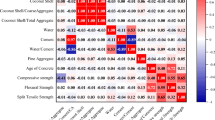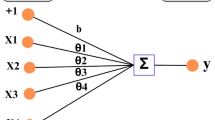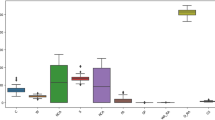Abstract
This research focuses on predicting Flexural Strength (Fck) in recycled aggregate-based concrete through a comprehensive approach integrating machine learning models and global sensitivity analysis. A dataset comprising 302 samples, including features like Cement, Sand, Natural Fine Aggregate, Recycled Fine Aggregate, Natural Coarse Aggregate, Recycled Coarse Aggregate, Water, W/C (Water/Cement Ratio), and Super Plasticizer, was gathered from existing literature. The study initially preprocesses the dataset, handling outliers through median values and scaling features to a range of 0 to 1. Five prominent machine learning models, namely Support Vector Regressor, Random Forest Regressor, Gradient Boosting Regressor, XGBoost, and Multi-Layer Perceptron, were selected as base models. These models were trained on the preprocessed dataset using fivefold cross-validation, and their performance was evaluated using metrics such as R2 Score, Root Mean Squared Error, Mean Absolute Error, and Mean Absolute Percentage Error. Subsequently, a stacking approach was employed, combining predictions from base models through a Linear Regression meta-model. The stacked model exhibited superior performance, achieving an R2 Score of 0.8826 and outperforming individual models. Visualizations, including radar plots and actual versus predictions plots, emphasized the enhanced accuracy and precision of the stacked model. Global sensitivity analysis highlighted the varying influences of input features, with recycled fine aggregate, water, and cement identified as critical contributors. The study concludes with insights into the relative importance of input features and suggests future directions for refinement and expansion, emphasizing the potential for more sustainable and resilient construction practices in recycled aggregate-based concrete.
















Similar content being viewed by others
Data Availability
The data used in the current study is available from the corresponding author, upon reasonable request.
Abbreviations
- SVR:
-
Support vector regressor
- RFR:
-
Random forest regressor
- GBR:
-
Gradient boosting regressor
- XGBoost:
-
Extreme gradient boosting regressor
- MLP:
-
Multi-layer perceptron
- RMSE:
-
Root mean squared error
- MAE:
-
Mean absolute error
- MAPE:
-
Mean absolute percentage error
- C&D:
-
Construction and demolition
- RAC:
-
Recycled aggregate concrete
- ANN:
-
Artificial neural network
- BPNN:
-
Back propagation neural network
- MLR:
-
Multiple linear regression
- ICA:
-
Imperialist competitive algorithm
- NCA:
-
Natural coarse aggregates
- NFA:
-
Natural fine aggregates
- LR:
-
Linear regression
- FFNN:
-
Feedforward neural network
- SWR:
-
Stepwise linear regression
- PSO:
-
Particle swarm optimization
- GPR:
-
Gaussian process regression
- SVM:
-
Support vector machine
- KNN:
-
K-nearest neighbors
- RA:
-
Recycled aggregates
- RCA:
-
Recycled coarse aggregate
- NC:
-
Normal concrete
- SF:
-
Silica fume
- IQR:
-
Interquartile range
- Q3:
-
Third quartile
- Q1:
-
First quartile
- LB:
-
Lower bound
- UB:
-
Upper bound
- ST:
-
Sobol total
- S1:
-
First-order sensitivity
- OLS:
-
Ordinary least squares
References
Aggarwal S, Singh R, Rathore A et al (2024) A novel data-driven machine learning techniques to predict compressive strength of fly ash and recycled coarse aggregates based self-compacting concrete. Mater Today Commun. https://doi.org/10.1016/j.mtcomm.2024.109294
Ahmad A, Ostrowski KA, Maślak M et al (2021) Comparative study of supervised machine learning algorithms for predicting the compressive strength of concrete at high temperature. Materials. https://doi.org/10.3390/ma14154222
Ahsan MM, Mahmud MAP, Saha PK et al (2021) Effect of data scaling methods on machine learning algorithms and model performance. Technologies (basel) 9:52. https://doi.org/10.3390/technologies9030052
Al-Zahraa FI, El-Mihilmy MT, Bahaa TM (2010) Flexural strength of concrete beams with recycled concrete aggregates. J Eng Appl Sci 57:355–375
Aprianti SE (2017) A huge number of artificial waste material can be supplementary cementitious material (SCM) for concrete production—a review part II. J Clean Prod 142:4178–4194. https://doi.org/10.1016/j.jclepro.2015.12.115
Auyo AM, Jibril MM, Malami S, Hauwa (2023) Experimental exploration of influential factors of concrete Flexural strength through features engineering techniques: Insight from machine learning prediction
Bassi A, Manchanda A, Singh R, Patel M (2023) A comparative study of machine learning algorithms for the prediction of compressive strength of rice husk ash-based concrete. Nat Hazards 118:209–238. https://doi.org/10.1007/s11069-023-05998-9
Bennett B, Visintin P, **e T (2022) Global warming potential of recycled aggregate concrete with supplementary cementitious materials. J Build Eng 52:104394. https://doi.org/10.1016/j.jobe.2022.104394
Biswal US, Mishra M, Singh MK, Pasla D (2022) Experimental investigation and comparative machine learning prediction of the compressive strength of recycled aggregate concrete incorporated with fly ash, GGBS, and metakaolin. Innov Infrastruct Solut 7:1–20. https://doi.org/10.1007/s41062-022-00844-6
Bonifazi G, Serranti S (2012) Recycling Technologies. Encyclopedia of Sustainability Science and Technology. Springer, New York, pp 8794–8848
Braga AM, Silvestre JD, de Brito J (2017) Compared environmental and economic impact from cradle to gate of concrete with natural and recycled coarse aggregates. J Clean Prod 162:529–543. https://doi.org/10.1016/j.jclepro.2017.06.057
Bu L, Du G, Hou Q (2021) Prediction of the compressive strength of recycled aggregate concrete based on artificial neural network. Materials. https://doi.org/10.3390/ma14143921
Chen ZP, Huang KW, Zhang XG, Xue JY (2010) Experimental research on the flexural strength of recycled coarse aggregate concrete. 2010 International conference on mechanic automation and control engineering, MACE2010 1041–1043. https://doi.org/10.1109/MACE.2010.5536744
Chen T, He T (2018) xgboost: eXtreme gradient boosting. R Package Version 071–2:1–4
Da Veiga S (2015) Global sensitivity analysis with dependence measures. J Stat Comput Simul 85:1283–1305. https://doi.org/10.1080/00949655.2014.945932
Dong H, Song Y, Cao W et al (2019) Flexural bond behavior of reinforced recycled aggregate concrete. Constr Build Mater 213:514–527. https://doi.org/10.1016/j.conbuildmat.2019.03.238
Dorogush AV, Ershov V, Gulin A (2018) CatBoost: gradient boosting with categorical features support. Comput Sci. https://doi.org/10.48550/ar**v.1810.11363
Fushiki T (2011) Estimation of prediction error by using K-fold cross-validation. Stat Comput 21:137–146. https://doi.org/10.1007/s11222-009-9153-8
Gardner MW, Dorling SR (1998) Artificial neural networks (the multilayer perceptron)—a review of applications in the atmospheric sciences. Atmos Environ 32:2627–2636. https://doi.org/10.1016/S1352-2310(97)00447-0
Gupta P, Gupta N, Saxena KK, Goyal S (2022) Multilayer perceptron modelling of geopolymer composite incorporating fly ash and GGBS for prediction of compressive strength. Adv Mater Process Technol 8:1441–1455. https://doi.org/10.1080/2374068X.2021.1946751
Habibi A, Ramezanianpour AM, Mahdikhani M, Bamshad O (2021) RSM-based evaluation of mechanical and durability properties of recycled aggregate concrete containing GGBFS and silica fume. Constr Build Mater 270:121431. https://doi.org/10.1016/j.conbuildmat.2020.121431
Hill M (2022) Random Forests. In: McGill University. https://www.math.mcgill.ca/yyang/resources/doc/randomforest.pdf
Ibrahim HA-H (2018) Bio-energy production from rice straw a review. Recent Adv Petrochem Sci. https://doi.org/10.19080/rapsci.2018.05.555671
Ignjatović IS, Marinković SB, Mišković ZM, Savić AR (2013) Flexural behavior of reinforced recycled aggregate concrete beams under short-term loading. Mater Struct/mater Et Constr 46:1045–1059. https://doi.org/10.1617/s11527-012-9952-9
Jung Y (2018) Multiple predicting K-fold cross-validation for model selection. J Nonparametr Stat 30:197–215. https://doi.org/10.1080/10485252.2017.1404598
Kapoor K, Singh SP, Singh B (2021) Permeability of self-compacting concrete made with recycled concrete aggregates and Portland cement-fly ash-silica fume binder. J Sustain Cem Based Mater 10:213–239. https://doi.org/10.1080/21650373.2020.1809029
Kathirvel P, Kaliyaperumal SRM (2016) Influence of recycled concrete aggregates on the flexural properties of reinforced alkali activated slag concrete. Constr Build Mater 102:51–58. https://doi.org/10.1016/j.conbuildmat.2015.10.148
Kaur A, Singh R (2024) Rice straw: status, management and strategies for sustainable development with special emphasis on the Northern India and government—supported initiatives. Clean Technol Environ Policy. https://doi.org/10.1007/s10098-024-02749-7
Khademi F, Jamal SM, Deshpande N, Londhe S (2016) Predicting strength of recycled aggregate concrete using artificial neural network, adaptive neuro-fuzzy inference system and multiple linear regression. Int J Sustain Built Environ 5:355–369. https://doi.org/10.1016/j.ijsbe.2016.09.003
Koushkbaghi M, Kazemi MJ, Mosavi H, Mohseni E (2019) Acid resistance and durability properties of steel fiber-reinforced concrete incorporating rice husk ash and recycled aggregate. Constr Build Mater 202:266–275. https://doi.org/10.1016/j.conbuildmat.2018.12.224
Kovačević M, Antoniou F (2023) Machine-learning-based consumption estimation of prestressed steel for prestressed concrete bridge construction. Buildings 13:1187. https://doi.org/10.3390/BUILDINGS13051187
Kovačević M, Bulajić B (2022) Material consumption estimation in the construction of concrete road bridges using machine learning. In: Glavaš H, Hadzima-Nyarko M, Karakašić M, Ademović N, Avdaković S (eds) Proceedings of 30th international conference on organization and technology of maintenance (OTO 2021). Springer International Publishing, Cham, pp 324–343. https://doi.org/10.1007/978-3-030-92851-3_24
Kovačević M, Ivanišević N, Petronijević P, Despotović V (2021) Construction cost estimation of reinforced and prestressed concrete bridges using machine learning. Graevinar 73:1–13
Kovačević M, Hadzima-Nyarko M, Grubeša IN et al (2023) Application of artificial intelligence methods for predicting the compressive strength of green concretes with rice husk ash. Mathematics 12:66. https://doi.org/10.3390/MATH12010066
Kumar S, Kapoor K, Singh RB (2022) Singh P (2022) Application of silica fume in high-volume fly ash self-compacting recycled aggregate concrete. Aust J Civ Eng. https://doi.org/10.1080/14488353.2022.2083426
Kumar R, Rathore A, Singh R et al (2023) Prognosis of flow of fly ash and blast furnace slag-based concrete: leveraging advanced machine learning algorithms. Asian J Civ Eng. https://doi.org/10.1007/s42107-023-00922-9
Kumar Tipu R, Panchal VR, Pandya KS (2022) An ensemble approach to improve BPNN model precision for predicting compressive strength of high-performance concrete. Structures 45:500–508. https://doi.org/10.1016/j.istruc.2022.09.046
Liu C, Lv Z, Zhu C et al (2019) Study on calculation method of long term deformation of rac beam based on creep adjustment coefficient. KSCE J Civ Eng 23:260–267. https://doi.org/10.1007/s12205-018-0131-6
Lu P, Chen S, Zheng Y (2012) Artificial intelligence in civil engineering. Math Probl Eng 2012:1–22. https://doi.org/10.1155/2012/145974
Malešev M, Radonjanin V, Marinković S (2010) Recycled concrete as aggregate for structural concrete production. Sustainability 2:1204–1225. https://doi.org/10.3390/su2051204
Mane KM, Kulkarni DK, Prakash KB (2019) Prediction of flexural strength of concrete produced by using pozzolanic materials and partly replacing NFA by MS. J Soft Comput Civ Eng 3:65–75. https://doi.org/10.22115/SCCE.2019.197000.1121
Mehta V (2023) Machine learning approach for predicting concrete compressive, splitting tensile, and flexural strength with waste foundry sand. J Build Eng 70:106363. https://doi.org/10.1016/j.jobe.2023.106363
Momeni E, Omidinasab F, Dalvand A et al (2022) Flexural strength of concrete beams made of recycled aggregates: an experimental and soft computing-based study. Sustainability (switzerland). https://doi.org/10.3390/su141811769
Muduli R, Mukharjee BB (2019) Effect of incorporation of metakaolin and recycled coarse aggregate on properties of concrete. J Clean Prod 209:398–414. https://doi.org/10.1016/j.jclepro.2018.10.221
Naser AH, Badr AH, Henedy SN et al (2022) Application of multivariate adaptive regression splines (MARS) approach in prediction of compressive strength of eco-friendly concrete. Case Stud Constr Mater 17:e01262. https://doi.org/10.1016/j.cscm.2022.e01262
Nassar R-U-D, Soroushian P (2012) Strength and durability of recycled aggregate concrete containing milled glass as partial replacement for cement. Constr Build Mater 29:368–377. https://doi.org/10.1016/j.conbuildmat.2011.10.061
Natekin A, Knoll A (2013) Gradient boosting machines, a tutorial. Front Neurorobot. https://doi.org/10.3389/fnbot.2013.00021
Olorunsogo FT, Padayachee N (2002) Performance of recycled aggregate concrete monitored by durability indexes. Cem Concr Res 32:179–185. https://doi.org/10.1016/S0008-8846(01)00653-6
Otsuki N, Miyazato S, Yodsudjai W (2003) Influence of recycled aggregate on interfacial transition zone, strength, chloride penetration and carbonation of concrete. J Mater Civ Eng 15:443–451. https://doi.org/10.1061/(ASCE)0899-1561(2003)15:5(443)
Pan B (2018) Application of XGBoost algorithm in hourly PM2.5 concentration prediction. IOP Conf Ser Earth Environ Sci 113:1–7. https://doi.org/10.1088/1755-1315/113/1/012127
Plaza P, Sáez del Bosque IF, Frías M et al (2021) Use of recycled coarse and fine aggregates in structural eco-concretes. Physical and mechanical properties and CO2 emissions. Constr Build Mater 285:122926. https://doi.org/10.1016/j.conbuildmat.2021.122926
Praveen Kumar VV, Naga P, Dey S (2020) Influence of metakaolin on strength and durability characteristics of ground granulated blast furnace slag based geopolymer concrete. Struct Concr 21:1040–1050. https://doi.org/10.1002/suco.201900415
Riedl MO (2019) Human-centered artificial intelligence and machine learning. Hum Behav Emerg Technol 1:33–36. https://doi.org/10.1002/hbe2.117
Rizvon SS, Jayakumar K (2021) Machine learning techniques for recycled aggregate concrete strength prediction and its characteristics between the hardened features of concrete. Arab J Geosci. https://doi.org/10.1007/s12517-021-08674-z
Sabău M, Remolina Duran J (2022) Prediction of compressive strength of general-use concrete mixes with recycled concrete aggregate. Int J Pavement Res Technol 15:73–85. https://doi.org/10.1007/s42947-021-00012-6
Shah HA, Yuan Q, Akmal U et al (2022) Application of machine learning techniques for predicting compressive, splitting tensile, and flexural strengths of concrete with metakaolin. Materials. https://doi.org/10.3390/ma15155435
Shang M, Li H, Ahmad A et al (2022) Predicting the mechanical properties of RCA-based concrete using supervised machine learning algorithms. Materials 15:647. https://doi.org/10.3390/ma15020647
Silva RV, de Brito J, Dhir RK (2014) Properties and composition of recycled aggregates from construction and demolition waste suitable for concrete production. Constr Build Mater 65:201–217. https://doi.org/10.1016/j.conbuildmat.2014.04.117
Singh R, Patel M (2022a) Contribution of waste paper sludge on the mechanical and durability attributes of concrete: a review. Environmental Concerns and Remediation. Springer International Publishing, Cham, pp 77–90
Singh R, Patel M (2022b) Investigating the effect of corn cob ash on the characteristics of cement paste and concrete: a review. Environmental Concerns and Remediation. Springer International Publishing, Cham, pp 91–103
Singh R, Patel M (2022c) Effective utilization of rice straw in value-added by-products: a systematic review of state of art and future perspectives. Biomass Bioenerg 159:106411. https://doi.org/10.1016/j.biombioe.2022.106411
Singh R, Patel M (2023) Experimental and machine learning approaches to investigate the application of sugarcane bagasse ash as a partial replacement of fine aggregate for concrete production. J Build Eng 76:107168. https://doi.org/10.1016/j.jobe.2023.107168
Sobol IM (1993) Sensitivity estimates for nonlinear mathematical models. Math Model Comput Exp 1:407
Sodhi AK, Bhanot N, Singh R, Alkahtani M (2022) Effect of integrating industrial and agricultural wastes on concrete performance with and without microbial activity. Environ Sci Pollut Res 29:86092–86108. https://doi.org/10.1007/s11356-021-16445-2
Song H, Ahmad A, Farooq F et al (2021) Predicting the compressive strength of concrete with fly ash admixture using machine learning algorithms. Constr Build Mater 308:1–15. https://doi.org/10.1016/j.conbuildmat.2021.125021
Sri Ravindrarajah R, Tam CT (1985) Properties of concrete made with crushed concrete as coarse aggregate. Mag Concr Res 37:29–38. https://doi.org/10.1680/macr.1985.37.130.29
Suryawanshi SR, Singh B, Bhargava P (2015) Characterization of recycled aggregate concrete. Advances in Structural Engineering. Springer India, New Delhi, pp 1813–1822
Tamayo P, Pacheco J, Thomas C et al (2020) Mechanical and durability properties of concrete with coarse recycled aggregate produced with electric arc furnace slag concrete. Appl Sci (switzerland). https://doi.org/10.3390/app10010216
Tong H, Chen DR, Peng L (2009) Analysis of support vector machines regression. Found Comput Math 9:243–257. https://doi.org/10.1007/s10208-008-9026-0
Venkateswara Rao A, Srinivasa Rao K (2019) Effect of fly ash on strength of concrete. Circ Econ Fly Ash Manag 14:125–134. https://doi.org/10.1007/978-981-15-0014-5_9
Visintin P, Dadd L, Ul Alam M et al (2022) Flexural performance and life-cycle assessment of multi-generation recycled aggregate concrete beams. J Clean Prod 360:132214. https://doi.org/10.1016/j.jclepro.2022.132214
Wadhawan S, Bassi A, Singh R, Patel M (2023) Prediction of compressive strength for fly ash-based concrete: critical comparison of machine learning algorithms. J Soft Comput Civ Eng 7:68–110
Wang D, Wang M, Qiao X (2009) Support vector machines regression and modeling of greenhouse environment. Comput Electron Agric 66:46–52. https://doi.org/10.1016/j.compag.2008.12.004
Wang Y, Zhang H, Geng Y et al (2019) Prediction of the elastic modulus and the splitting tensile strength of concrete incorporating both fine and coarse recycled aggregate. Constr Build Mater 215:332–346. https://doi.org/10.1016/j.conbuildmat.2019.04.212
Wang B, Yan L, Fu Q, Kasal B (2021) A comprehensive review on recycled aggregate and recycled aggregate concrete. Resour Conserv Recycl 171:105565. https://doi.org/10.1016/j.resconrec.2021.105565
**ao J, Li W, Fan Y, Huang X (2012) An overview of study on recycled aggregate concrete in China (1996–2011). Constr Build Mater 31:364–383. https://doi.org/10.1016/j.conbuildmat.2011.12.074
Yuan X, Tian Y, Ahmad W et al (2022) Machine Learning Prediction Models to Evaluate the Strength of Recycled Aggregate Concrete. Materials 15:1–25. https://doi.org/10.3390/ma15082823
Zeini HA, Al-Jeznawi D, Imran H et al (2023) Random forest algorithm for the strength prediction of geopolymer stabilized clayey soil. Sustainability 15:1408. https://doi.org/10.3390/su15021408
Zhang P (2019) A novel feature selection method based on global sensitivity analysis with application in machine learning-based prediction model. Appl Soft Comput 85:105859. https://doi.org/10.1016/j.asoc.2019.105859
Zheng D, Wu R, Sufian M et al (2022) Flexural strength prediction of steel fiber-reinforced concrete using artificial intelligence. Materials. https://doi.org/10.3390/ma15155194
Acknowledgements
The suggestions provided by colleagues which helped the authors in improving the quality of the research work is appreciatively acknowledged.
Funding
The authors did not receive support from any organization for the submitted work. The authors have no relevant financial or non-financial interests to disclose. All authors also certify that they have no affiliations with or involvement in any organization or entity with any financial interest or non-financial interest in the subject matter or materials discussed in this manuscript. The authors have no financial or proprietary interests in any material discussed in this article.
Author information
Authors and Affiliations
Contributions
R.S. and R.K.T. wrote the main manuscript text, and A.A.M. and M.P. revised the Manuscript and prepared figures and tables. All authors reviewed the manuscript.
Corresponding author
Ethics declarations
Conflict of interest
The authors declare that they have no conflict of interest.
Human and Animal Rights
No animals or humans were harmed during the execution of this work reported in the article.
Rights and permissions
Springer Nature or its licensor (e.g. a society or other partner) holds exclusive rights to this article under a publishing agreement with the author(s) or other rightsholder(s); author self-archiving of the accepted manuscript version of this article is solely governed by the terms of such publishing agreement and applicable law.
About this article
Cite this article
Singh, R., Tipu, R.K., Mir, A.A. et al. Predictive Modelling of Flexural Strength in Recycled Aggregate-Based Concrete: A Comprehensive Approach with Machine Learning and Global Sensitivity Analysis. Iran J Sci Technol Trans Civ Eng (2024). https://doi.org/10.1007/s40996-024-01502-w
Received:
Accepted:
Published:
DOI: https://doi.org/10.1007/s40996-024-01502-w




